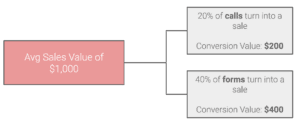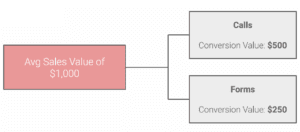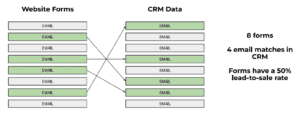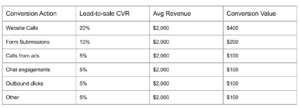No single healthcare organization can help everybody. With so many different niches and treatment and care subsets within healthcare, patient experiences across various services can vary extensively. This means some healthcare organizations will be better positioned to optimize outcomes for a specific set of patients and services, and other patients will be better off going elsewhere for their health needs.
Table of Contents
These facts have a direct impact on the media strategies healthcare marketers should use to reach new patients.
Google’s AI-powered solutions, like Smart Bidding and Performance Max, allow marketers to reach more people efficiently, but are they reaching the right people? Without setting proper campaign parameters, Google’s algorithmic bidding strategies can run amok and target the wrong people.
Healthcare marketers who don’t set robust lead quality control measures will suffer from poor lead quality. Their incoming leads end up not converting into booked appointments, which wastes time and money.
This is particularly true for organizations operating in senior care, addiction treatment, and plastic surgery space–offerings that require more research and patient consideration before making a final purchase decision.
Why is Lead Quality Difficult to Control in Healthcare?
The healthcare industry is slow to adopt new technologies due to compliance hurdles, lack of capital, HIPAA regulations, and its inherent complexity. This lag impacts marketing technology adoption as well.
Cardinal’s State of Healthcare Marketing report found that 47% of healthcare organizations do not use a customer relationship management system (CRM). As a result, they lack visibility into the leads that convert into actual patients.
Healthcare consumers often turn to the phone to ask questions and book an appointment. Phone calls are inherently nebulous and difficult to measure in terms of quality. On the other hand, website forms are often prone to bot submissions. Both must be handled differently.
We also see challenges due to:
- Maximize Conversions and Target CPA campaign types that value every conversion action equally regardless of value
- Conversion values are not set based on average revenue received from the last stage in the lead-to-sale journey and associated conversion rates
- Leads are not vetted after the conversion occurs to look at what queries drove the conversion or what happened on the call.
All of which can contribute to poor lead quality. To increase lead quality, lead-to-sale conversion rates, and revenue in a CRM-less world, healthcare marketers must take control of their Google Ads accounts. Here’s how:
1. Ensure Conversion Actions are Appropriate for Business Objectives
Conversions are defined as when the recipient of a marketing message performs a desired action, such as visiting a page, submitting a form, or calling. However, not all conversion actions are equal.
They vary in quality and, therefore, should not be treated the same.
Unfortunately, with Target CPA bidding, conversion quality is not taken into account. Instead, this approach sources the lowest-cost conversions first and only expands to higher-cost conversions once the lower-cost funnel is depleted.
As a result, Target CPA bidding leads to more conversions coming from calls instead of from your website or form submissions, which may end up having a higher value (we talk about quantifying conversion values below).
For you as a marketer, this means you must train your algorithm based on your business objectives. If you want to drive more business from your website, the algorithm should be tweaked to give preference to those incoming customers.
Here are our recommendations to assign conversion quality depending on where your conversions currently come from.
For Organizations Using a Paid Call Tracking Solution
If you use a paid call tracking solution such as CallRail, Invoca, or Callbox, you can filter out unqualified calls from the ad platform. This will train the algorithm to chase conversions based on criteria that you define—instead of Google.
As a baseline, we recommend that all calls passed to the platform should be at least 60 seconds long (and even higher for some healthcare specialties).
Calls from ads can be tested for quality, and tags can be used to score calls based on the conversation rate between customers and agents. You can also filter between new vs. existing patients and filter out callers who are calling about actions not relevant to your current campaign, such as canceling an appointment, making a payment, billing, directions, etc. By filtering out all these calls and tagging calls where the customer has indicated that they took the desired action of scheduling an appointment, you can add a higher value to these in the ad platform so that you bid on those types of calls.
If you find that calls are overwhelmingly unqualified, call extensions should be removed from your campaigns.
For Organizations Not Using a Paid Call Tracking Solution
If you are not using a paid call tracking solution, you can still take steps to drive more qualified calls, such as a click-to-call conversion action using Google’s free call tracking solution. These calls should also be at least 60 seconds long and can (and should) be tested for quality.
In addition to filtering out low-quality phone calls and bot form submissions, you must also clean up extraneous conversion actions. In other words, you must measure unique conversion actions that represent the lowest funnel actions that can be taken by de-duping/purging duplicate conversions and removing extraneous conversion actions that are not driving value.
2. Assign Values to Conversion Actions to Prioritize Different Conversion Types
Conversion values help you measure the true business impact of your ad campaigns. Without them, you will be unable to separate low-quality conversions from high-quality ones, which is the dilemma we are trying to help healthcare marketers overcome.
By assigning values to your conversions, you can quantify the total value driven by your advertising across different conversions rather than simply the number of conversions. This will ultimately help you focus on the business actions and campaigns that contribute the most to your bottom line.
We outline the steps you should take for the four most common value-assigning scenarios seen in practice below.
Assigning Conversion Values with Known Conversion Rates
When there are known differences in the lead-to-sale rate across different conversion types, assign conversion values to conversion actions appropriately. For example, if it is known that the value of an acquisition is $1,000 and 20% of calls become patients while 40% of forms become patients, forms are worth twice each call, and you can assign conversion values appropriately for both calls and forms.

Based on your niche, current outreach channels, and conversion figures, tweak weights for calls vs. forms vs. other channels you are using to maximize profit while taking the cost of each channel and the potential cannibalization of conversions and leads into account.
Assigning Conversion Values with Directional Conversion Rates
If the specific conversion rates from lead to sale for different conversion actions are not known, but you know that one conversion type is of higher quality than another, then you can use directional values instead of percentages as above for weighing the value of conversion actions.

For example, if you know that forms convert to a sale at a higher rate than calls, you can set a value for forms that is twice the value of calls. Continuing with our example above, you could set forms to a value of $500 while calls are set to $250. The actual values themselves are not important; what is important is the ratio of the conversion values between different channels, and this is what will direct your bidding strategy with a meaningful distinction between each channel.
Assigning Conversion Values with Unknown Conversion Rates
If there are no known differences in lead-to-sale conversion rate across conversion types, you should listen to website calls and calls from ads (if they are being used) to determine which leads to lower-quality incoming calls. You can then set a lower directional conversion rate. Form submission data can also be used to gauge the conversion rate from lead to sale by cross-referencing form submissions with CRM data provided by the client, and this can also help you assign values to forms vs. website calls vs. other outreach channels you may be using.

Assigning Conversion Values with Only One Conversion Action
If you use only one conversion action, the value of the conversion action should be the value of a new acquisition multiplied by 20% (for example, a $1,000 new acquisition value x 20% = $200 value).
For every other scenario not covered by the three-pronged strategy above, you should assign conversion values as below:

3. Use Value-Based Bidding
After assigning conversion actions, you should switch to value-based bidding using either Maximize Conversion Value or Target ROAS. These bidding strategies will ensure that the algorithm respects the values you determined for each conversion action.
We recommend waiting six weeks before moving your campaigns to a value-based bidding strategy. This learning period will give campaigns a smoother transition as Google Ads learns which conversions are the most valuable. Campaign experiments such as this should be used to test such a bidding strategy without sacrificing all of your daily budget, and you will also gain more insight into whether your assigned values are correct and are working as expected.
For multi-local accounts, campaign experiments should be made on a handful of locations to gauge how campaigns will react to the switch, which will inform how the rest of the campaigns are switched.
Conclusion
As is true for data and statistics of any kind, the value of your outputs depends largely on the quality of your inputs. As we say in computer science, garbage in means garbage out.
In other words, flawed or low-quality input data will produce flawed or low-quality outputs.
AI-powered advertising platforms, such as Google Ads, are a highly beneficial option when it comes to targeting new users and driving more business, but these services work best when managed hands-on by someone who understands how to fine-tune and calibrate the system to target high-value, high-quality leads vs. low-value, low-quality leads and how to train the system to iteratively target such users.
If you can consistently do so over successive short-terms, you can create a long-term incoming pipeline of high-quality leads–and that is the ultimate goal of every marketer.

